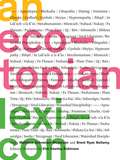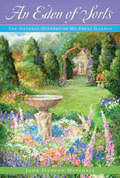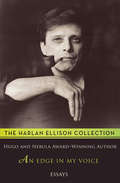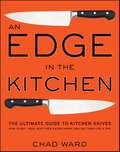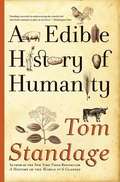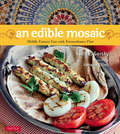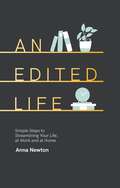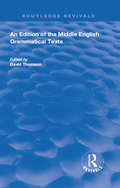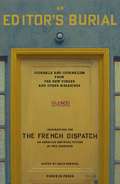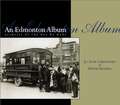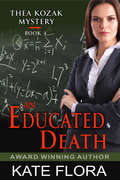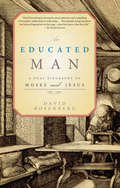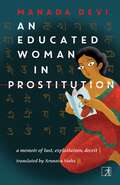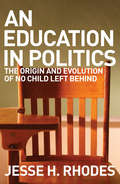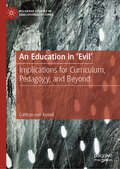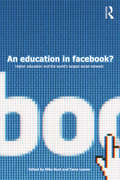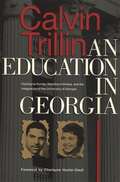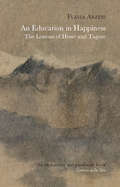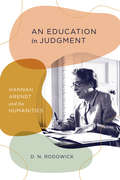- Table View
- List View
An Ecotopian Lexicon
by Kim Stanley Robinson Karen O'Brien David N. Pellow Kari Marie Norgaard Randall Amster Daniel Worden Rebecca Evans Sheena Wilson Anthony Lioi Andrew Pendakis Sam Solnick Brent Ryan Bellamy Melody Jue Andrew Alan Johnson Yifei Li Carolyn Fornoff Evelyn O'Malley Sofia Ahlberg Malcolm Sen Chris Pak Allison Ford Jennifer Lee Johnson Michael Horka Ann Kristin Schorre John Esposito Kira Bre Clingen Miraim Tola Charis Boke Pierre-Héli Monot Andrew Hageman Janet Tamalik McGrath Kimberly Skye Richards Robert Savino Oventile Cherice BockPresents thirty novel terms that do not yet exist in English to envision ways of responding to the environmental challenges of our generation As the scale and gravity of climate change becomes undeniable, a cultural revolution must ultimately match progress in the realms of policy, infrastructure, and technology. Proceeding from the notion that dominant Western cultures lack the terms and concepts to describe or respond to our environmental crisis, An Ecotopian Lexicon is a collaborative volume of short, engaging essays that offer ecologically productive terms—drawn from other languages, science fiction, and subcultures of resistance—to envision and inspire responses and alternatives to fossil-fueled neoliberal capitalism. Each of the thirty suggested &“loanwords&” helps us imagine how to adapt and even flourish in the face of the socioecological adversity that characterizes the present moment and the future that awaits. From &“Apocalypso&” to &“Qi,&” &“ ~*~ &“ to &“Total Liberation,&” thirty authors from a range of disciplines and backgrounds assemble a grounded yet dizzying lexicon, expanding the limited European and North American conceptual lexicon that many activists, educators, scholars, students, and citizens have inherited. Fourteen artists from eleven countries respond to these chapters with original artwork that illustrates the contours of the possible better worlds and worldviews.Contributors: Sofia Ahlberg, Uppsala U; Randall Amster, Georgetown U; Cherice Bock, Antioch U; Charis Boke, Cornell U; Natasha Bowdoin, Rice U; Kira Bre Clingen, Harvard U; Caledonia Curry (SWOON); Lori Damiano, Pacific Northwest College of Art; Nicolás De Jesús; Jonathan Dyck; John Esposito, Chukyo U; Rebecca Evans, Winston-Salem State U; Allison Ford, U of Oregon; Carolyn Fornoff, U of Illinois at Urbana-Champaign; Michelle Kuen Suet Fung; Andrew Hageman, Luther College; Michael Horka, George Washington U; Yellena James; Andrew Alan Johnson, Princeton U; Jennifer Lee Johnson, Purdue U; Melody Jue, U of California, Santa Barbara; Jenny Kendler; Daehyun Kim (Moonassi); Yifei Li, NYU Shanghai; Nikki Lindt; Anthony Lioi, Juilliard School of New York; Maryanto; Janet Tamalik McGrath; Pierre-Héli Monot, Ludwig Maximilian U of Munich; Kari Marie Norgaard, U of Oregon; Karen O&’Brien, U of Oslo, Norway; Evelyn O&’Malley, U of Exeter; Robert Savino Oventile, Pasadena City College; Chris Pak; David N. Pellow, U of California, Santa Barbara; Andrew Pendakis, Brock U; Kimberly Skye Richards, U of California, Berkeley; Ann Kristin Schorre, U of Oslo, Norway; Malcolm Sen, U of Massachusetts Amherst; Kate Shaw; Sam Solnick, U of Liverpool; Rirkrit Tiravanija, Columbia U; Miriam Tola, Northeastern U; Sheena Wilson, U of Alberta; Daniel Worden, Rochester Institute of Technology.
An Ecumenical Field Guide For Fresh Expressions
by Michael Adam BeckLearn the essentials of fresh expressions for your church.An Ecumenical Field Guide for Fresh Expressions is a practical manual for understanding and implementing Fresh Expressions for a church in any denominational setting.The Fresh Expressions movement is a new way of thinking about the local church and a new way of doing church as a congregation. It refers to new (fresh) iterations or types (expressions) of ministry, usually outside the confines of the church building. These iterations or types of ministries are formed intentionally but organically out in the community, where people are. They are based on shared activities or interests, where people are gathering already, and where the people are open to or interested in learning about Jesus. Christian people share their own stories of how Jesus is part of their lives. Often, these gatherings become regular and increasingly begin to adopt the practices of a church community, like worship, service, study, and giving. Thus, they become fresh expressions of the church from which they sprang.
An Ed-Tech Tragedy?: Educational Technologies and School Closures in the Time of COVID-19
by Mark WestThe COVID-19 pandemic pushed education from schools to educational technologies at a pace and scale with no historical precedent. For hundreds of millions of students, formal learning became fully dependent on technology – whether internet-connected digital devices, televisions or radios.An Ed-Tech Tragedy? examines the numerous adverse and unintended consequences of the shift to ed-tech. It documents how technology-first solutions left a global majority of learners behind and details the many ways education was diminished even when technology was available and worked as intended.Using tragedy as a metaphor and borrowing the organization of a three-act theatrical play, the book shows how technology-first modes of learning introduced novel health and safety risks, handed significant control of public education to for-profit companies, expanded invasive digital surveillance and carried detrimental environmental repercussions, in addition to adversely impacting educational access, equity, quality and outcomes in most contexts.Dedicated sections consider alternative and less technology-reliant educational responses to COVID-19 disruptions that had the potential to be more inclusive and equitable. The analysis further explains how pandemic models of learning are rippling beyond school closures and influencing the future of education.Holistically, the work invites readers to reconsider a turbulent chapter in education history and reexamine the purposes and roles of technology in education.
An Eden of Sorts: The Natural History of My Feral Garden
by John Hanson MitchellTwenty-five years ago John Hanson Mitchell cut down a 1 1/2-acre stand of seventy-five-year-old white pines and planted a garden in their place. An Eden of Sorts is a history of the plants and animals that lived on the tract over the next decades. In a survey he made before taking down the pines, Mitchell counted no more than five or six flowering plants and shrubs. Over the years he created a series of fanciful garden "rooms" in the Italian style. Now, in addition to an intriguing garden of earthly delights, he has recorded more than one thousand species of plants and animals on the property. This is a paradoxical yet hopeful narrative of what can happen to a plot of land when it is properly managed.
An Edge in My Voice: Essays
by Harlan EllisonAt the beginning of the 1980s, Harlan Ellison agreed to write a regular column for the L.A. Weekly on the condition that they published whatever he wrote with no revisions and no suggestions for rewrites. What resulted was impassioned, persuasive, abusive, and hilarious. Part essay, part conversation, all Ellison--these pieces provide a glimpse into a great mind, at ease in tackling both grand ideas and the minutiae of the day to day. Collected here in An Edge in My Voice, these works also open a window to a decade when a newspaper would accept such a risky venture from such a powerful voice,
An Edge in the Kitchen: The Ultimate Guide to Kitchen Knives
by Chad WardWhy are most of us so woefully uninformed about our kitchen knives? We are intimidated by our knives when they are sharp, annoyed by them when they are dull, and quietly ashamed that we don't know how to use them with any competence. For a species that has been using knives for nearly as long as we have been walking upright, that's a serious problem. An Edge in the Kitchen is the solution, an intelligent and delightful debunking of the mysteries of kitchen knives once and for all. If you can stack blocks, you can cut restaurant-quality diced vegetables. If you can fold a paper airplane, you can sharpen your knives better than many professionals.Veteran cook Chad Ward provides an in-depth guide to the most important tool in the kitchen, including how to choose the best kitchen knives in your price range, practical tutorials on knife skills, a step-by-step section on sharpening, and more——all illustrated with beautiful photographs throughout. Along the way you will discover what a cow sword is, and why you might want one; why chefs are abandoning their heavy knives in droves; and why the Pinch and the Claw, strange as they may sound, are in fact the best way to make precision vegetable cuts with speed and style. An Edge in the Kitchen is the one and only guide to the most important tool in the kitchen.
An Edible Alphabet
by Bonnie ChristensenEach page shows a letter of the alphabet in capital and small, a picture with the name of a plant, and pictures showing how the plant is used. A multi-cultural, multi-generational cast of characters makes this an unusual alphabet.
An Edible History of Humanity
by Tom StandageIn this book, Tom Standage charts the enlightening history of humanity through the foods we eat. More than simply sustenance, food historically has been a kind of technology, changing the course of human progress by helping to build empires, promote industrialization, and decide the outcomes of wars. Tom Standage draws on archaeology, anthropology, and economics to reveal how food has helped shape and transform societies around the world, from the emergence of farming in China by 7500 b.c. to the use of sugar cane and corn to make ethanol today.
An Edible Mosaic
by Faith GorskyWhen Faith Gorsky married her Middle Eastern husband, she married more than just the man. She found herself introduced to a culture and cuisine that would forever change how she experienced food and cooking.Faith's mother-in-law took her under her wing and in 6 months gave her a thorough course in Middle Eastern cooking that became the basis for her popular website, An Edible Mosaic. The growth and success of her website and her own developing interest led to more trips to the Middle East, deepening her knowledge of the cuisine which she shares in An Edible Mosaic.In her new cookbook, Faith imparts her favorite Middle Eastern recipes, recipes anyone can make with a little work and some help from Faith! Her love for the cuisine of her husband's homeland shows in her enthusiasm for these dishes and the awareness that food is more than just a means of sustenance for the people of the Middle East-it lies at the epicenter of their gatherings with family and friends.Recipes include:Parsley Salad with Bulgur Wheat (Tabbouleh)Creamy Chickpea and Yogurt Casserole (Fetteh)Mashed Fava Beans with Olive Oil, Lemon Juice, and Garlic (Foul Mudammas)Ground Chicken Kebabs (Kebab Dajaj)Sumac-Spiced Chicken (M'sakhkhan)Upside-Down Rice Casserole (Maqluba)Date-Filled Cookies (Ma'amoul)
An Edited Life: Simple Steps to Streamlining your Life, at Work and at Home
by Anna NewtonDeclutter every aspect of your life - from your wardrobe, exercise schedule and food budget to your phone, bookshelves and beauty regime - with this realistic guide to getting neat and keeping things that way.Anna Newton is just trying to balance work, her friends, her family, her husband Mark, a growing handbag habit and a love for takeaway pizza. Over the past 8 years of running the blog and corresponding YouTube Chanel ‘The Anna Edit’, she’s grown a loyal viewership who tune in for her weekly videos on everything from house renovations to the best summer foundation.Anna is a typical Virgo – she loves being organised. She’s Marie Kondo’d her house, nearly throwing away her TV remote in the process. She’s waved goodbye to her things with Fumio Sasaki. She’s minimized and bullet-journalled her schedules down to the finest detail. Along the way, she’s realised something key: there’s no one prescription for an organized life, a tidy home and calm mind. Instead, it’s all about editing.Learn how to edit your home, calendar, exercise regime, social life, me-time, wardrobe, household budget, digital detox, beauty routine and office space. It's about how to utilise your time and spend more of it doing what makes you happy.
An Edition of the Middle English Grammatical Texts (Routledge Revivals)
by David ThomsonPublished in 1984: This is a working text and guide to the context of treatises which have so far not played their full part in the study of the late Middle Ages.
An Editor’s Burial: Journals and Journalism from the New Yorker and Other Magazines
by Various Wes AndersonA scintillating collection of inspirations for Wes Anderson's star-studded tenth film The French Dispatch--fascinating essays on the expatriate experience in Paris by some of the twentieth century's finest writers.A glimpse of post-war France through the eyes and words of 14 (mostly) expatriate journalists including Mavis Gallant, James Baldwin, A.J. Liebling, S.N. Behrman, Luc Sante, Joseph Mitchell, and Lillian Ross; plus, portraits of their editors William Shawn and New Yorker founder Harold Ross. Together: they invented modern magazine journalism. Includes an introductory interview by Susan Morrison with Anderson about transforming fact into a fiction and the creation of his homage to these exceptional reporters.
An Edmonton Album: Glimpses of the Way We Were
by Jo-Anne Christensen Dennis ShappkaThis album is a collection of sentimental journeys into Edmonton’s past - a time when a dime was all that was needed to see a movie, and couples skated across the glassy surface of a frozen lake that is now gone. These photos illustrate many important historical events and changes in Edmonton, from its fur-trading beginnings through decades of tremendous growth. Through the lens of a camera we revisit soldiers returning home from war; the first train rumbling into town; the first school, hospital, and business; the building of the Legislature and demolition of the original fort; the desperation of the "Dirty Thirties"; and the success of the initial oil boom. More than one hundred and fifty black-and-white images allow us to travel back in time to revisit Edmonton’s growth and its people. Through these photos, moments in Edmonton’s past are captured eternally, rich with details that characterize the era. An Edmonton Album is the city’s memory - in pictures.
An Educated Death: A Thea Kozak Mystery (The Thea Kozak Mystery Series #4)
by Kate FloraWhen a student is found drowned in the campus pond of a prestigious New England boarding school, Thea Kozak is called in for crisis management. Cooperation abounds until Thea discovers that the young victim was pregnant and the death may not have been an accident. Then administration and students turn tight-lipped. When Thea digs deeper, she unearths a host of nasty secrets beneath the school’s genteel facade.Now everyone wants her gone, everyone except the killer who has a very different fate in mind for Thea Kozak.REVIEWS:"If a sleep-losing page turner is your thing, keep an eye on Thea." Richard Barre, award-winning author of the Wil Hardesty SeriesTHE THEA KOZAK MYSTERY SERIES, in orderChosen for DeathDeath in a Funhouse MirrorDeath at the WheelAn Educated DeathDeath in ParadiseLiberty or DeathStalking DeathDeath Warmed Over
An Educated Man: A Dual Biography of Moses and Jesus
by David RosenbergA magisterial project: a dual biography of the preeminent figures of Judeo–Christian civilization overturning conventional views of Moses and Jesus as humble men of faith.By reanimating the biographies of Moses and Jesus in their historical context, Rosenberg reads their narrative as a cultural—rather than religious—endeavor. He charges that Moses and Jesus were "educated" men, steeped in the literature and scholarship of their day. There were no old or new testaments for them, only a long history of writing and writers. When scholars and clergy quote Moses and Jesus, they routinely neglect to inform us that Jesus is quoting the Hebrew Bible, often in the manner that Moses quoted Egyptian medical texts. The remarkable ability of both men to recall and transform a wide range of sources is overlooked. Where did they get these profound educations? Part biography, part critical analysis, An Educated Man challenges us to envision what defines "an educated man or woman" today—and how understanding religious history is crucial to it. Rosenberg offers a sympathetic approach to why we need Judeo–Christianity—and ultimately convinces us that the life of Jesus is unthinkable without the model of Moses before him.
An Educated Woman In Prostitution: A Memoir of Lust, Exploitation, Deceit (Calcutta, 1929)
by Manabi Devi&‘But now, having travelled to the frontier of the world of sins, I no longer hesitated in trampling over the remnants of the goodness in my heart.&’Manada, Maani didi, Feroza Bibi, Miss Mukherjee – the jostling identities of our beguiling and charming protagonist as she glides through a life that can be seen as exploitative yet, also, curiously, empowering and honest. Manada&’s fascinating life story takes her from her wealthy cossetted upbringing to a life of debauchery and prostitution after she elopes with her married lover when in her mid-teens. She is capable, attractive and doesn&’t ask for pity as she struggles with illness, poverty and abandonment, but ensures that she emerges relatively unscathed and carves a niche for herself in her profession.Manada matures and settles into a life of prostitution, entertains barristers, doctors and other men of high society. She describes her colourful life with relish but is often introspective as she places her own position as a sex worker in the context of the times, calling out young sanctimonious patriotic men who maintain a high standing in society yet secretly fancy prostitutes. Rather tantalisingly she takes no names, only occasionally hinting at their identities, to avoid scandals and protect the double lives of men who are well-known in Calcutta in the 1920s. Weaving together multiple strands, looking beyond ideas of morality and accusations, we are presented a life of immense beauty and endurance, which is both grand in its scope and deeply intimate in its portrait.
An Education
by Katharine O'NeillRena and Tracey mean to spend Christmas with their respective partners, only to find out Rena’s boyfriend and Tracey’s girlfriend are planning on spending Christmas with each other. Jilted and betrayed, Rena and Tracey decide to spend Christmas alone, together. A couple of glasses of wine later, and both are willing to forget everything about their ex-partners. Maybe it’s the alcohol talking, but Rena’s curious to know what it’s like to make love to a woman. And Tracey is happy to oblige.
An Education
by Nick HornbyFrom the New York Times bestselling author—the shooting script to his award-winning film, with an original Introduction and vivid stills from the movie. Jenny is a 16-year-old girl stifled by the tedium of adolescence; she can’t wait for her sophisticated adult life to begin. One rainy day her suburban existence is upended by the arrival of David, a much older suitor who introduces her to a glittering new world of concerts, art, smoky bars, urban nightlife, and his glamorous friends, replacing her traditional education with his own version. It could be her awakening—or her undoing. This edition of Hornby’s adapted screenplay, which includes stills from the film, is a perfect accompaniment to the highly anticipated movie, which stars Carey Mulligan as Jenny, Peter Sarsgaard, Emma Thompson, Dominic Cooper, and Alfred Molina. It is a must-have for fans of Hornby’s novels, featuring his signature pitch-perfect dialogue, mordant wit, and the resonant humanity of his writing. Watch a Video .
An Education In Politics
by Jesse H. RhodesSince the early 1990s, the federal role in education-exemplified by the controversial No Child Left Behind Act (NCLB)-has expanded dramatically. Yet states and localities have retained a central role in education policy, leading to a growing struggle for control over the direction of the nation's schools. In An Education in Politics, Jesse H. Rhodes explains the uneven development of federal involvement in education. While supporters of expanded federal involvement enjoyed some success in bringing new ideas to the federal policy agenda, Rhodes argues, they also encountered stiff resistance from proponents of local control. Built atop existing decentralized policies, new federal reforms raised difficult questions about which level of government bore ultimate responsibility for improving schools. Rhodes's argument focuses on the role played by civil rights activists, business leaders, and education experts in promoting the reforms that would be enacted with federal policies such as NCLB. It also underscores the constraints on federal involvement imposed by existing education policies, hostile interest groups, and, above all, the nation's federal system. Indeed, the federal system, which left specific policy formation and implementation to the states and localities, repeatedly frustrated efforts to effect changes: national reforms lost their force as policies passed through iterations at the state, county, and municipal levels. Ironically, state and local resistance only encouraged civil rights activists, business leaders, and their political allies to advocate even more stringent reforms that imposed heavier burdens on state and local governments. Through it all, the nation's education system made only incremental steps toward the goal of providing a quality education for every child.
An Education in 'Evil': Implications for Curriculum, Pedagogy, and Beyond (Palgrave Studies in Educational Futures)
by Cathryn van KesselThis book asserts that engaging with divergent understandings about the nature of evil and how it functions can help those interested in education think through issues in curriculum, pedagogy, and beyond. The author provokes thinking about and through the concept of evil in the spirit of thoughtful education (as opposed to thoughtless schooling) toward how we might live together in less harmful ways. Although thinking about evil can be uncomfortable and troubling, such inquiries help us explore what sort of relations we want to have with others. Analyzing our role in evil as humans, as well as our responsibilities to counter the processes of evil present in our everyday lives, opens up a potential to foster radical thought in and out of the classroom.
An Education in Facebook?: Higher Education and the World's Largest Social Network
by Mike Kent Tama LeaverAn Education in Facebook? examines and critiques the role of Facebook in the evolving landscape of higher education. At times a mandated part of classroom use, at others an informal network for students, Facebook has become an inevitable component of college life, acting alternately as an advertising, recruitment and learning tool. But what happens when educators use a corporate product, which exists outside of the control of universities, to educate students? An Education in Facebook? provides a broad discussion of the issues educators are already facing on college campuses worldwide, particularly in areas such as privacy, copyright and social media etiquette. By examining current uses of Facebook in university settings, this book offers both a thorough analytical critique as well as practical advice for educators and administrators looking to find ways to thoughtfully integrate Facebook and other digital communication tools into their classrooms and campuses.
An Education in Georgia: Charlayne Hunter, Hamilton Holmes, and the Integration of the University of Georgia
by Calvin TrillinIn January 1961, following eighteen months of litigation that culminated in a federal court order, Hamilton Holmes and Charlayne Hunter became the first black students to enter the University of Georgia. Calvin Trillin, then a reporter for Time Magazine, attended the court fight that led to the admission of Holmes and Hunter and covered their first week at the university--a week that began in relative calm, moved on to a riot and the suspension of the two students "for their own safety," and ended with both returning to the campus under a new court order. Shortly before their graduation in 1963, Trillin came back to Georgia to determine what their college lives had been like. He interviewed not only Holmes and Hunter but also their families, friends, and fellow students, professors, and university administrators. The result was this book--a sharply detailed portrait of how these two young people faced coldness, hostility, and occasional understanding on a southern campus in the midst of a great social change.
An Education in Happiness
by Howard Curtis Flavia ArzeniHappiness "is neither a privilege of the few, nor a fleeting state of mind: it is hidden behind a door that every person can open once they have found it, at the end of an arduous journey of self-discovery."The two Nobel Prize-winning writers Rabindranath Tagore and Hermann Hesse are arguably very different: one comes to us from the core of Indian culture, the other from the very heart of Old Europe; the former is an eternal wanderer, the latter a determined armchair traveller. Still, there are extraordinary affinities between their works, and they both understood that the path to happiness is paved with small acts and simple notions.Flavia Arzeni's book offers us an oasis of stability and calm in which we can find the answers to our fundamental concerns about life and happiness.
An Education in Judgment: Hannah Arendt and the Humanities
by D. N. RodowickIn An Education in Judgment, philosopher D. N. Rodowick makes the definitive case for a philosophical humanistic education aimed at the cultivation of a life guided by both self-reflection and interpersonal exchange. Such a life is an education in judgment, the moral capacity to draw conclusions alone and with others, and in letting one’s own judgments be answerable to the potentially contrasting judgments of others. Thinking, for Rodowick, is an art we practice with and learn from each other on a daily basis. In taking this approach, Rodowick follows the lead of Hannah Arendt, who made judgment the cornerstone of her conception of community. What is important for Rodowick, as for Arendt, is the cultivation of “free relations,” in which we allow our judgments to be affected and transformed by those of others, creating “an ever-widening fabric of intersubjective moral consideration.” That is a fragile fabric, certainly, but one that Rodowick argues is worth pursuing, caring for, and preserving. This original work thinks with and beyond Arendt about the importance of the humanities and what “the humanities” amounts to beyond the walls of the university.
An Education in Judgment: Hannah Arendt and the Humanities
by D. N. RodowickIn An Education in Judgment, philosopher D. N. Rodowick makes the definitive case for a philosophical humanistic education aimed at the cultivation of a life guided by both self-reflection and interpersonal exchange. Such a life is an education in judgment, the moral capacity to draw conclusions alone and with others, and in letting one’s own judgments be answerable to the potentially contrasting judgments of others. Thinking, for Rodowick, is an art we practice with and learn from each other on a daily basis. In taking this approach, Rodowick follows the lead of Hannah Arendt, who made judgment the cornerstone of her conception of community. What is important for Rodowick, as for Arendt, is the cultivation of “free relations,” in which we allow our judgments to be affected and transformed by those of others, creating “an ever-widening fabric of intersubjective moral consideration.” That is a fragile fabric, certainly, but one that Rodowick argues is worth pursuing, caring for, and preserving. This original work thinks with and beyond Arendt about the importance of the humanities and what “the humanities” amounts to beyond the walls of the university.
